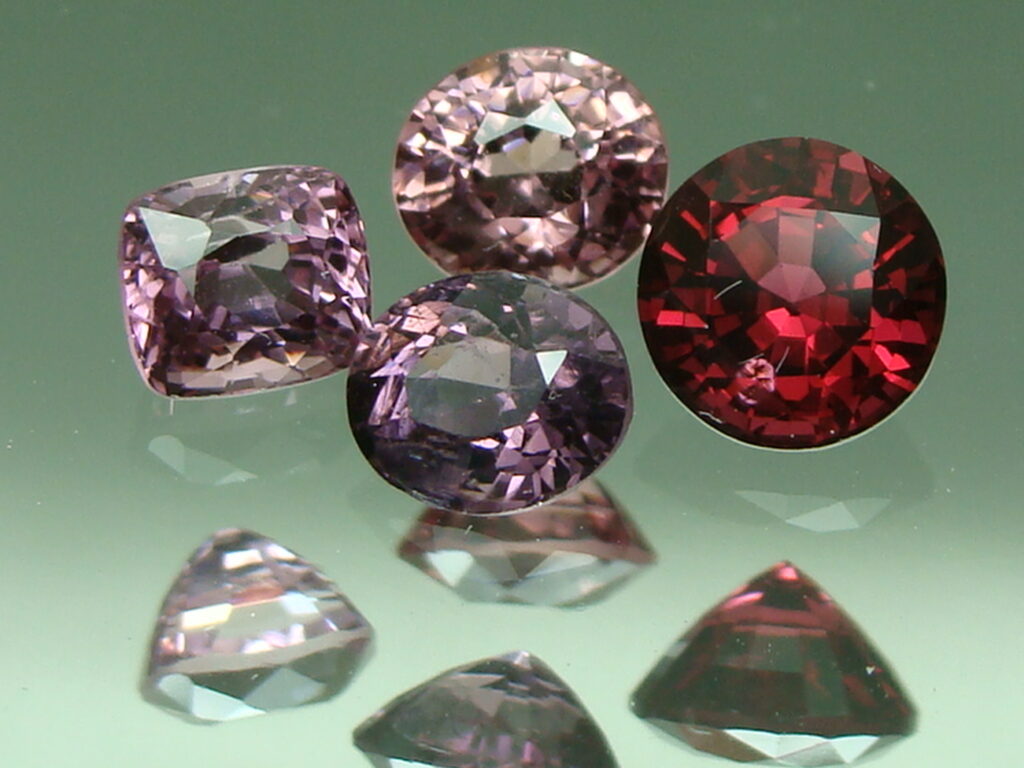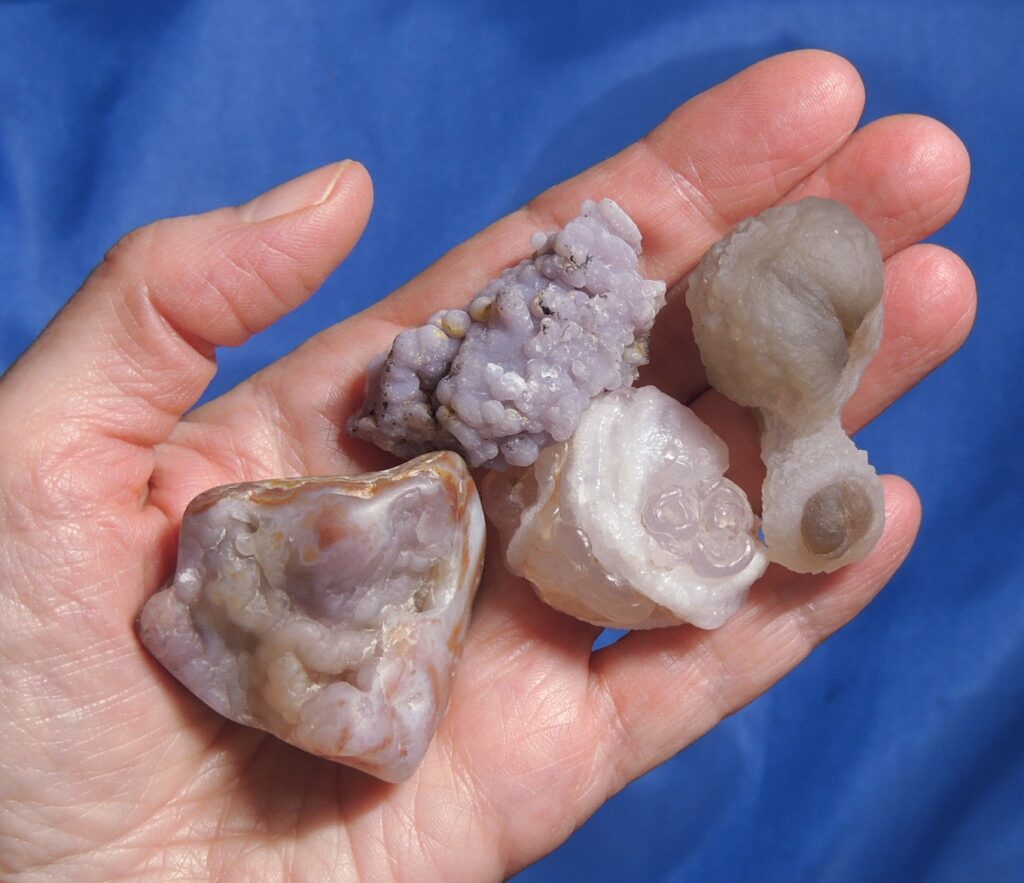13 Beautiful Violet Gemstones: Everything You Need To Know
Purple and violet gemstones have been useful in jewelry since people worked out how to make these pieces.
This luxurious tone emanates elegance and sophistication wherever you wear it. You may not be aware though of just how many purple and violet gemstones there are out there, and what each can be in use for.
With that in mind, we've compiled a list of purple diamonds and gemstones in almost any shade you can think of, from violet, lilac, lavender, and mauve.
If you are thinking about buying a purple gemstone for a special occasion or as a treat to yourself, then take a look at this list of the very best purple gemstones.
RELATED: Popular Purple Gemstones That You Need To Add To Your Collection
Spinel
While purple spinels are rare, they have a cheap price than many of the other gemstones that you’ll find on this list.
This magnificent diamond is available in a number of purple colors, the most popular of which are lilac and mauve.

Spinel itself is available in several colors, though the purple shades are the most popular and well-loved.
Purple spinel is popular for everyday jewelry due to its toughness (8 on the Mohs scale), yet it suits any ensemble, as with other stones.
While some purple spinels are cultivated in laboratories, the majority are wild and untreated. It is impossible to intentionally recreate the stone's purple hue in a lab, as beryllium occurs naturally in the stone.
So you will be able to see a subtle difference between lab-grown and natural when placed side by side. Spinels are presently sourced in Tajikistan, Myanmar, Sri Lanka, and Afghanistan.
Chalcedony
Purple Chalcedony is a kind of quartz discovered in the Indonesian town of Mamuju. Its many purple tones might appear opaque or translucent.
Purple Chalcedony ranges in color from mild lilac to deep purple, making it a highly sought-after gemstone among purple enthusiasts. Additionally, it is inexpensive, costing between $10 and $500 depending on the color.

This stone has a Mohs hardness of 6.5 to 7. It is devoid of cleavages—that is, its crystals do not fracture in the same direction—which makes it incredibly durable and straightforward to maintain.
The spectrum of purple colors in this gemstone is great for everyday use and works nicely with a bohemian style.
It complements a range of jewelry designs, from bold necklaces and rings to delicate earrings and bracelets.
Iolite
This diamond is incredibly dazzling and may rival Tanzanite and Sapphire in terms of brilliance. It is available in both purple and blue tones, but the most popular is the purple-violet shade.
The term "iolite" comes from the Greek word "Ios," which translates as "violet." Despite its low price and widespread availability, this stone bears the appearance of a more costly diamond.

This makes it an ideal choice if you're seeking a stunning purple stone on a budget. It ranges in price from $9 to $50, though this depends on the stone's look and condition.
Regrettably, despite its Mohs hardness of 7 to 7.5, iolite is brittle and prone to chipping. Due to the stone's prominent cleavage in one direction, it is fragile, so you must be careful when handling or wearing jewelry that contains this stone.
To prolong the life of your piece, consider purchasing it as a necklace or earrings to prevent colliding with anything as you move around. Wearing this stone as a ring is not advisable as it will almost certainly chip or break.
Fluorite
Although fluorite gemstones come in a range of colors, their most recognizable shade is a brilliant purple. Although this translucent stone is extremely popular for spiritual ceremonies, it is rarely in use in jewelry.
If you choose to wear Fluorite jewelry, the best option is to opt for earrings—or another minimally invasive alternative.

Typically, fluorite jewels are created from brightly colored stones. They may, however, be descended from those with less vibrant color forms.
Due to its deep purple hue, Fluorite is sometimes mistaken for Amethyst. Additionally, it is extremely brilliant when exposed to UV light, earning it the moniker Fluorite.
Due to the stone's fragility, it is normally exclusively acquired by gemstone collectors. It has a Mohs hardness of 4 and can fracture in four directions.
To avoid chipping or scratching your Fluorite stones, you must use extreme caution. You can find fluorite in significant quantities in the United Kingdom, the United States, Mexico, Australia, Brazil, Germany, Peru, Norway, and China.
Kunzite
While not as well-known as the others, this stone is as stunning as many on this list. Its predominant hues are pink and purple, and it is well-known for its pleochroism, which means that it displays two colors.
Additionally, Kunzite is famous for its phosphorescence which is light emitted by a substance without the need for combustion. Diamonds have a similar look to them.

Kunzite is a relatively new gemstone that was discovered in 1902 and named after George Frederick Kunz, a gemologist at Tiffany & Co.
George Kunz discovered it in California, and it is found in substantial quantities in Brazil, Pakistan, and Afghanistan.
While purple Kunzite is frequently a pale purple, it may also be a vivid, strong purple. Kunzite is available for purchase at a price of between $10 and $20 per carat.
The best stones should be transparent, untreated, and free of inclusions. Although Kunzite has a Mohs hardness of 6.5 to 7, due to its cleavage, it lacks tenacity, so you should be careful when handling these stones to avoid damage or breakage.
Jasper
While you can find most jasper a reddish tint, it is also available in a purple hue. It's an unusual-looking stone with a natural pattern similar to Kunzite, meaning that no two stones are identical.
Additionally, purple jasper is more transparent than the other colors. And, like Sugilite, it is rarely faceted, allowing its inherent brilliance to shine through.

Purple jasper is exceptionally hard, with a Mohs hardness of between 6.5 and 7. Due to the unique patterning and veining structure of purple jasper, it is extremely durable.
When properly cared for, this stone has the potential to last an extraordinarily long time. Additionally, it's unique, concentrated style pairs beautifully with other statement pieces and costume jewelry.
The creation of purple jasper is by fusing red and blue jasper, giving the stone a warm tone. Additionally, it imparts a sense of grandeur without breaking the bank.
You can find jasper on every continent. They are more commonly found in Australia, Uruguay, India, Egypt, Venezuela, Russia, Madagascar, Indonesia, Kazakhstan, and Brazil, among other places.
Fortunately, it is a more reasonable gemstone than some of the others on our list, with a price range of $5 to $50.
Agate
Purple agate is a quartz crystal-based stone with spectacular layers of white and purple colors. While this gemstone is naturally colored, certain kinds have been dyed to achieve its shade.
Despite this, these stones are quite popular in the jewelry industry due to the stunning contrast of vibrant purples and delicate white bands.

Purple agates come in a range of sizes and shapes, and their pricing reflects their origin, inventiveness, and craftsmanship.
For instance, a pair of earrings may cost $5, yet a necklace may cost up to $100. Naturally, this is also dependent on the piece's color intensity.
Purple agate is a kind of agate that may you can find in Brazil and Botswana. It has a Mohs hardness of around 7 and is free of cleavage, making it durable enough to wear daily.
Diamond
These are some of the most extravagant jewels available. While diamonds are often translucent, some of the most magnificent are naturally colored. Purple diamonds form when a large amount of hydrogen is present during the diamond's formation.
Purple diamonds are significantly more durable than their ordinary counterparts as well, making them almost indestructible. This is because hydrogen hardens the diamond.

Jewelers determine the diamond's value by evaluating the stone's purple tint. A deep purple diamond is very rare and hence more costly than a diamond with a faint orchid tint.
RELATED: Better Than Crown Jewels – 12 Jazzy Crystals For Jewelry Making
Purple diamonds are available in a range of hues including lavender, Grape, orchid, and lilac.
Additionally, these stones are highly pricey, ranging between $1,900 and $25,000 per carat, due to their much bigger carat weight than standard diamonds.
Purple diamonds are extremely difficult to locate due to their scarcity. They occur in a few scattered locations in Canada, Russia, and Australia.
Amethyst
Amethyst is probably the most popular and well-known purple gemstone. It was formerly valued on a par with diamonds, rubies, and sapphires.
Regrettably, this phase ended when large numbers were discovered in Brazil, making them extremely common nowadays.

Amethysts come in a range of shades of purple, making them popular with those who enjoy the hue. The darkest hues are the best and most expensive.
Prices for amethysts range from $10 to $700, depending on their grade. While stones with a deeper hue may attract a higher price, extended exposure to sunlight can cause them to lose their color.
Amethyst gemstones complement both colorful and neutral ensembles, making them a wonderful addition to any woman's jewelry collection.
Lighter tones provide your combination an impression of tenderness, while darker hues may make you look more active.
Keep in mind, however, that Amethyst has a Mohs hardness value of 7, so avoid scratching or bumping your amethyst ring or bracelet.
Sapphire
While sapphires are most frequently identified with their magnificent blue hue, they are also available in an exquisite purple hue.
Due to the rarity of sapphires with a purple hue, purple sapphires are significantly more luxurious than blue sapphires. Additionally, due to the inherent purple color, these stones seldom require treatment.

Unfortunately, purple sapphire's hue can fade when exposed to radiation and heat. If this gem is overheated, the color will fade.
However, you may alter its color to a limited extent. When a dark purple sapphire is handled, it acquires a reddish color, whereas warming a lighter purple sapphire darkens its hue.
Purple sapphire's generation depends on its exposure to a high concentration of chromium during its development.
Due to the strength and beauty of this stone, it is a fantastic choice for those seeking a colorful engagement ring. Its value is between $800 to $5,000 and has a Mohs hardness rating of 9.
RELATED: Make A Statement: The Most Beautiful Crystals For Jewelry
Jade
While jade is predominantly a green gemstone, it does exist in a purple variety. Purple jade comes in a range of colors, from pale purple to deep purple.
Additionally, these stones have a glossy sheen and a smooth texture, yet they might appear waxy and dull at times. Additionally, while this gemstone is not naturally translucent, its value increases as it gets more transparent.

Purple jade has a Mohs hardness of 6.5 to 7, however, it is susceptible to damage from abrasive and sharp objects.
Avoid abrasive cleaners when washing your purple jade; you should wash it with water and mild soap and then dried with a soft cloth. While China is the main market for this gemstone, the best purple jade is found in Myanmar.
Tourmaline
Tourmaline, one of the most often seen gemstones, comes in a range of colors, including purple, ranging from vivid magenta to darker purple. This stone is highly faceted and may occasionally undergo heat treatment to enhance its brilliance.
Before buying this stone, you should inquire with your jeweler if it has been treated or not. Pinkish to red-colored stones, in particular, are treated to enhance their hue.

Tourmaline is extremely durable, with a Mohs hardness of 7-7.5, and costs between $400 and $2000. Purple tourmaline is found around the world, although the biggest reserves are found in Brazil.
Sugilite
Outside of Asia, sugilite, one of the most sought-after gemstones on this continent, is nearly unknown. Ken-ichi Sugi, a Japanese geologist, discovered it in 1944. It is available in transparent or opaque forms and has a distinctive purple hue.
There are, however, delicate pink-purple varieties. The finest sugilite must be both evenly toned and have a bright purple color.

Due to the fragility of sugilite, its application in jewelry is unusual, but it does happen rarely. Nonetheless, Sugilite is a gorgeous stone with an unusual pattern that is unique to each stone.
With a Mohs hardness of 5.5 to 6.5, sugilite jewelry is best reserved for special occasions.
This stone occurs naturally and is seldom enhanced by jewelers. That is why the majority of people get it in its natural condition.
Additionally, despite the fact that sugilite has been referred to as purple turquoise, the two minerals are unrelated. Sugilite deposits are found in
Japan, Australia, Canada, South Africa, and India.
Buying Purple Gemstones - What You Need To Know
Here are a few factors to consider when buying a purple gemstone.

Hardness
Each gemstone possesses a unique degree of hardness. Take note of the Mohs hardness grade of the stone.
Softer stones, such as Fluorite, are fragile and should only be in use in exceptional circumstances. A durable gemstone, such as a diamond, is ideal for daily wear.
Cut
Certain types of cuts are more common than others. An oval shape evenly distributes the gemstone's weight while retaining the gem's beauty and brilliance.
Certain customers may overlook the cut as an indicator of quality. However, the way a stone is carved can affect its brightness, as the shape alters how light reaches the stone.
Carrats
This is the most often in use grading system. The term "carat" refers to the weight of the jewels. While larger carat weights do not always imply a higher-quality stone, they typically do imply a greater price. Determine the carat weight and the presence of any inclusions or flaws.
Color
Purple gemstones come in a wide range of colors and tones. Think about this aspect a lot, as the color of some stones determines their grade and value.
For example, iolites are appreciated for their pleochroic properties, whilst deep purple amethysts are the most sought-after kind.
The Band
Bear in mind that while selecting purple gemstone jewelry, the gemstone is not the sole consideration. Additionally, you must consider the material or metal utilized in the piece—it will affect its quality and beauty.
Choose white or silver metals to highlight the purple gemstone's brilliance. You may choose from the following options:
- Silver
- White Gold
- Platinum
Additionally, you should consider the quality of the metal. If you want to utilize silver, ensure that it is 925 sterling silver to ensure its durability.
When acquiring raw stones, pay close attention to the gem's color and if it complements the metal color in which it is mounted.
Yellow gold is another option for lighter purple gemstones since it highlights the more delicate colors.
Final Thoughts
And there you have it, a list of the best violet gemstones out there! Whichever you decide to purchase, we are sure it will bring some calmness to your life.
RELATED: Keep Calm – 17 Charming Crystals To Help Keep You Calm
Be sure to check out our buying guide to help you narrow your search and find the right gemstone for you and your life.

